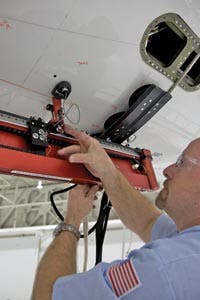Cover: Airframe Technology: Corrosion Control
They say experience is the best teacher.
And when it comes to corrosion control at Gulfstream Aerospace Corporation, that edict is definitely true.
Learning from past experience plays an important role in the ongoing corrosion-prevention efforts at this Savannah-based business-jet manufacturer. Thanks to its 50-year business-aviation history, the company draws on past experiences to influence future efforts.
Over the last five decades, this OEM has found that the best way to keep corrosion at bay and ensure an aircraft’s continued airworthiness is to be proactive from the beginning. The company focuses on a multi-layered corrosion-control program: Start with the right kind of material. Bring in the right plating, primer, and paint. Add some corrosion-inhibiting compounds and corrosion shouldn’t come calling.
But that isn’t all this company does. When it comes to corrosion, the design of an aircraft is just as important as the materials used to build it. The fewer pockets where moisture, acids, and salt can accumulate, the better. Since it is nearly impossible to prevent all water accumulation, especially in the lower part of the aircraft where water tends to pool, Gulfstream incorporates drainage into the aircraft’s design.
That, combined with a decent dose of vigilance, helps keep corrosion away. Toward that end, Gulfstream continuously monitors its fleet to ensure that it remains corrosion-free. Like a cancer, if corrosion is caught early, it can be treated and repaired.
Preventive maintenance is also a Gulfstream mantra. The company integrates corrosion topics — how to prevent, detect, and repair it — into its overall training and maintenance program. Additionally, Gulfstream requires operators to adhere to the inspection schedule and maintenance practices outlined in Chapter 5 of the Aircraft Maintenance Manual.
Gulfstream has also incorporated corrosion prevention into its research and development agenda. For many years, the company’s aggressive corrosion control has included nondestructive testing (NDT) such as fluorescent penetrant, eddy current, ultrasonic radiographic, and magnetic particle testing.
Since 2006, Gulfstream has introduced two new forms of NDT testing to its arsenal of test equipment — MAUS V (Mobile Automated Scanner — version 5) and OmniScan.
The MAUS V system, which was developed by Boeing, is a c-scan inspection system that integrates multi-frequency eddy current and ultrasonic methods. It is able to scan deep into multi-layered aluminum in search of corrosion or cracks.
Among the advantages of the MAUS V are its portability and speed. Also, scans conducted by the MAUS V can be emailed to engineers and technicians, or saved for comparisons to future scans.
The OmniScan phased array, which is made by Olympus, is a portable, multi-element inspection unit that uses eddy current or ultrasonic technologies to detect corrosion or cracks in multi-layered aluminum. OmniScan can’t penetrate as deeply as the MAUS V, but it can be set up faster and it may be able to inspect more complex geometries.
Typical applications for the MAUS V are the fuselage, outboard TE box, and leading edges, while OmniScan is often used to inspect a cockpit window exterior skin, cabin windows, and baggage door corners.
Gulfstream continues to explore emerging NDT technologies to reduce aircraft downtime for inspections, increase aircraft availability, enhance inspection reliability, increase machine reliability, and cut down inspection time.
Gulfstream is always looking for ways to improve its aircraft, and that includes enhanced corrosion protection. Among the things Gulfstream Service Engineering has done in this area is to send protective coatings for some aircraft components for testing at the NASA Kennedy Space Center’s Corrosion Technology Laboratory in Florida. The lab subjects various coated components to varying temperatures, as well as humidity, rain, wind, and ultraviolet rays, to determine which is the most corrosion-resistant. The most promising coatings will be used in future aircraft designs.
Composite materials are also being evaluated as a possible remedy for the corrosion and aging issues associated with aluminum aircraft. Composites are not subject to corrosion in the same way that metallic structures are. However, if a metal is being used as a component of a composite material, corrosion could still occur. Therefore, careful considerations and insulation of metal components is a must during the design/development of composite assemblies containing metal.
In addition to its own corrosion-control efforts, Gulfstream relies on operators to share their knowledge of corrosion. The company has formed a number of teams, including a basic maintainability group, a safety review team, and a customer advisory board, to provide feedback on a host of topics, including corrosion.
When it comes to preventing corrosion, an aviation company’s work is never done.
Fred Karst is director of Service Engineering at Gulfstream Aerospace Corporation, Savannah, GA.


